Dipole dipole forces Study guides, Class notes & Summaries
Looking for the best study guides, study notes and summaries about Dipole dipole forces? On this page you'll find 634 study documents about Dipole dipole forces.
Page 2 out of 634 results
Sort by
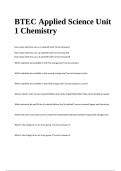
-
BTEC Applied Science Unit 1 Chemistry (Graded)
- Exam (elaborations) • 31 pages • 2024
-
- $12.99
- + learn more
BTEC Applied Science Unit 1 Chemistry (Graded) How many electrons can a d subshell hold? correct answer10 Which subshells are available in the first energy level? correct answers Which subshells are available in the second energy level? correct answers and p Which subshells are available in the third energy level? correct answers, p and d What is Hund's rule? correct answerOrbitals must all be singly filled before they can be doubly occupied Which elements do not fill the 4s subshell befor...
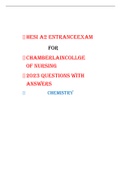
-
HESI A2 CHEMISTRY-CHRISJAY FILES (1) (1)
- Exam (elaborations) • 54 pages • 2023
-
- $14.99
- 1x sold
- + learn more
HESI A2 ENTRANCEEXAM FOR CHAMBERLAINCOLLGE OF NURSING 2023 QUESTIONS WITH ANSWERS CHEMISTRY HESI A2 CHEMISTRY V1/V2 FILE 1. If a Hydrogen isin a compound, what would its oxidation number be? +1 2. What isthe oxidation number of any simple ion? +1 or -1 depending on the charge of the ion 3. How many kilograms are in a pound? 0. kg 4. What is the temperature for freezing point of water in Celsius? 0 degrees Celsius (32°F for Fahrenheit) 5. What is the conversion of Celsius to Fah...
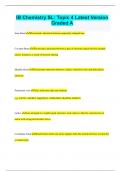
-
IB Chemistry SL: Topic 4 Latest Version Graded A
- Exam (elaborations) • 30 pages • 2024
- Available in package deal
-
- $10.49
- + learn more
IB Chemistry SL: Topic 4 Latest Version Graded A Ionic Bond Electrostatic attraction between oppositely charged ions Covalent Bond Electrostatic attraction between a pair of electrons and positively charged nuclei, formed as a result of electron sharing Metallic Bond Electrostatic attraction between a lattice of positive ions and delocalized electrons Polyatomic ions ions with more than one element e.g. CaCO3, Al(OH)3, Mg(NO3)2, (NH4)2SO4, Ba3PO4, LiHCO3 Lattice ions arran...
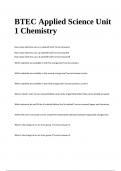
-
BTEC Applied Science Unit 1 Chemistry - Distinction.
- Exam (elaborations) • 31 pages • 2024
-
- $13.49
- + learn more
BTEC Applied Science Unit 1 Chemistry - Distinction. How many electrons can an s subshell hold? correct answer2 How many electrons can a p subshell hold? correct answer6 How many electrons can a d subshell hold? correct answer10 Which subshells are available in the first energy level? correct answers Which subshells are available in the second energy level? correct answers and p Which subshells are available in the third energy level? correct answers, p and d What is Hund's rule? correct ...
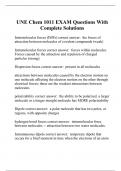
-
UNE Chem 1011 EXAM Questions With Complete Solutions
- Exam (elaborations) • 24 pages • 2023
- Available in package deal
-
- $12.99
- + learn more
Intermolecular forces (IMFs) correct answer: the forces of attraction between molecules of covalent compounds (weak) Intramolecular forces correct answer: forces within molecules. Forces caused by the attraction and repulsion of charged particles (strong) Dispersion forces correct answer: present in all molecules attractions between molecules caused by the electron motion on one molecule affecting the electron motion on the other through electrical forces; these are the weakest inter...
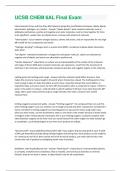
-
UCSB CHEM 6AL Final Exam Questions With 100% Correct Answers.
- Exam (elaborations) • 16 pages • 2024
- Available in package deal
-
- $8.49
- + learn more
Intermolecular forces and how they affect physical properties /purification techniques: dipole-dipole, electrostatic, hydrogen, ion, london, - Answer-*dipole-dipole*: polar covalent molecules such as aldehydes and ketones. positive and negative end. polar molecules must be close together for force to be significant. weaker than ion-dipole forces; increase with polarity of molecule. *electrostatic*: occur between charged species, cations and anions, and are responsible for very high MP and B...
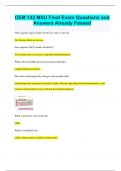
-
CEM 142 MSU Final Exam Questions and Answers Already Passed
- Exam (elaborations) • 26 pages • 2024
- Available in package deal
-
- $9.99
- + learn more
CEM 142 MSU Final Exam Questions and Answers Already Passed Does aqueous sugar conduct electricity, why or why not No, because there are no ions Does aqueous NaCl conduct electricity? Yes, because this is an ionic compound (metal/nonmetal) What is the only IMF present in non polar molecules London Dispersion Forces How does electronegativity change in the periodic table Electronegativity increases from left to right (with the right being most electronegative), and increases from bo...

-
TEST BANK for Organic Chemistry: 4th Edition by David R Klein. INTEGRATED WITH SOLUTIONS MANUAL. (All Chapters 1-27 Q&A)
- Other • 2150 pages • 2024
-
- $22.99
- + learn more
TABLE OF CONTENTS 1 A Review of General Chemistry 1.1 Introduction to Organic Chemistry 1.2 The Structural Theory of Matter 1.3 Electrons, Bonds, and Lewis Structures 1.4 Identifying Formal Charges 1.5 Induction and Polar Covalent Bonds 1.6 Reading Bond-Line Structures 1.7 Atomic Orbitals 1.8 Valence Bond Theory 1.9 Molecular Orbital Theory 1.10 Hybridized Atomic Orbitals 1.11 Predicting Molecular Geometry: VSEPR Theory 1.12 Dipole Moments and Molecular Polarity 1.13 Intermolecular Forces and Ph...
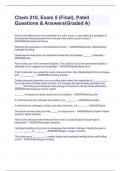
-
Chem 210, Exam 5 (Final), Patell Questions & Answers(Graded A)
- Exam (elaborations) • 7 pages • 2024
- Available in package deal
-
- $10.99
- + learn more
Chem 210, Exam 5 (Final), Patell Questions & AnWhat is the difference in the properties of a solid, liquid, or gas reflect the strengths of the attractive forces between the molecules that make up each phase? - ANSWERintermolecular forces What are the examples of intermolecular forces? - ANSWERdispersion, dipole-dipole, hydrogen bonding Dipole-dipole interactions are attractive forces that act between ______ molecules. - ANSWERpolar Polar molecules have permanent dipoles. The positive e...
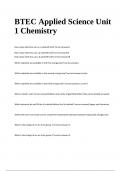
-
BTEC Applied Science Unit 1 Chemistry - Distinction.
- Exam (elaborations) • 31 pages • 2024
-
- $13.99
- + learn more
BTEC Applied Science Unit 1 Chemistry - Distinction. How many electrons can an s subshell hold? correct answer2 How many electrons can a p subshell hold? correct answer6 How many electrons can a d subshell hold? correct answer10 Which subshells are available in the first energy level? correct answers Which subshells are available in the second energy level? correct answers and p Which subshells are available in the third energy level? correct answers, p and d What is Hund's rule? correct ...

How did he do that? By selling his study resources on Stuvia. Try it yourself! Discover all about earning on Stuvia


